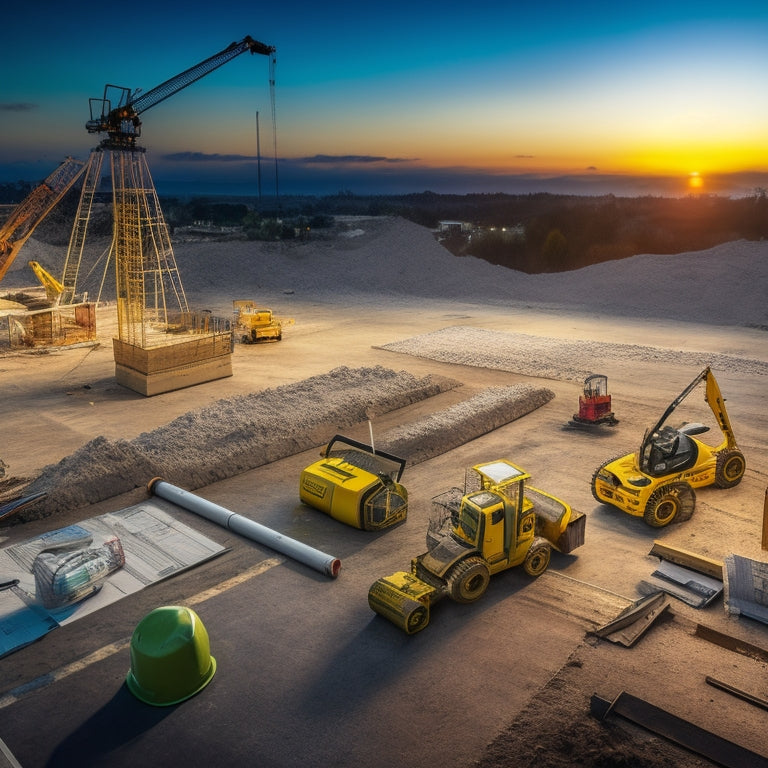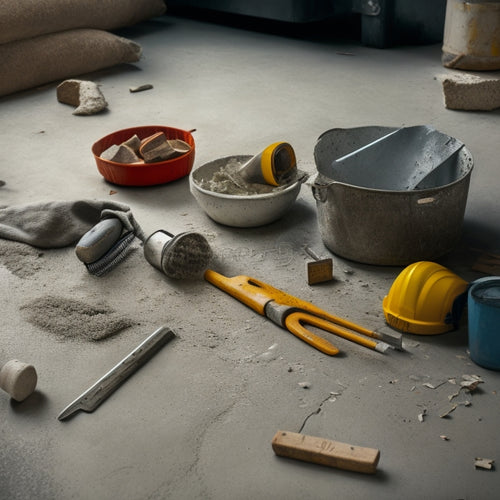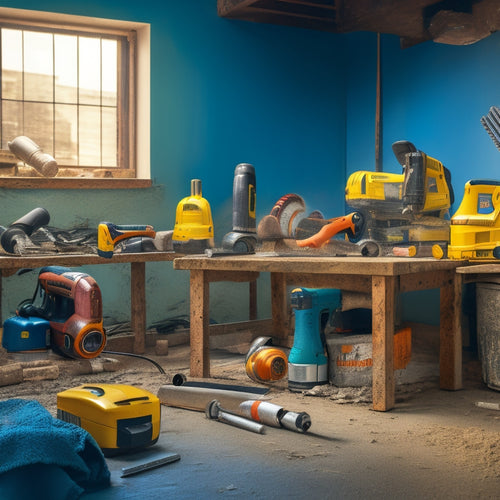
Top 3 Tools for Concrete Wall Construction
Share
When constructing a concrete wall, you'll need the right tools to guarantee structural integrity and prevent mistakes. First, a high-quality formwork system with sturdy panels, frames, and supports is essential to withstand concrete weight and pressure. Next, specialized finishing equipment like trowels, edgers, and jointers help achieve a smooth, even surface. Finally, an efficient setting system with anchors, ties, and curing processes ensures the wall meets structural requirements. With these top 3 tools, you'll be well on your way to a successful project - and there's more to explore to assure your concrete wall construction project's long-term success.
Key Takeaways
• A high-quality trowel is essential for concrete application and finishing, ensuring a smooth and even surface.
• Edgers and jointers are necessary for preventing surface defects and achieving a professional finish.
• Finishing blades are vital for removing excess concrete and creating a clean, smooth finish.
• A secure and stable formwork system is critical for supporting the concrete wall during construction.
• Mastery of trowel techniques, such as floating and finishing, is required to achieve a high-quality concrete finish.
Essential Formwork Components
When building a concrete wall, you'll need to assemble a formwork system comprising several essential components that work together to hold the freshly poured concrete in place. These components include formwork materials such as panels, frames, and supports that provide structural integrity to the system.
You'll need to select high-quality formwork materials that can withstand the weight and pressure of the concrete, guaranteeing the wall's stability and safety.
The formwork system's structural integrity relies on the proper assembly and alignment of its components. You must ascertain that the panels are securely fastened to the frames, and the frames are anchored to the ground or adjacent structures.
Any weaknesses or defects in the formwork system can lead to catastrophic failures, resulting in injuries or fatalities.
Must-Have Finishing Equipment
You'll need a range of specialized finishing equipment to achieve a smooth, even finish on your concrete wall. This equipment is vital for guaranteeing the surface is free from defects and imperfections. A high-quality trowel is essential for applying and finishing the concrete.
You'll need to master various trowel techniques, such as floating and finishing, to achieve the desired texture and appearance. Additionally, you'll require specialized tools for surface treatments, including edgers, jointers, and finishing blades. These tools help create a uniform surface and prevent defects like cracks and honeycombing.
When selecting finishing equipment, prioritize safety and durability. Look for tools with ergonomic handles and durable materials that can withstand the rigors of concrete construction.
It's also important to follow proper operating procedures and maintenance schedules to guarantee the equipment remains in good working condition. By investing in the right finishing equipment and honing your skills, you'll be able to achieve a high-quality finish that meets industry standards and enhances the overall appearance of your concrete wall.
Efficient Setting Systems
With a smooth, even finish achieved, it's time to focus on the efficient setting systems that guarantee your concrete wall meets structural integrity requirements.
You'll want to make certain that your wall can withstand external forces, such as wind and earthquakes, and internal stresses, like shrinkage and settlement. To achieve this, you'll need to implement efficient setting systems that prioritize safety measures.
One vital aspect of these systems is the use of anchors and ties to secure the wall to the foundation or adjacent structures. This prevents separation and guarantees the wall remains stable.
Additionally, you'll need to take into account the type and quality of concrete, as well as the curing process, to ensure it reaches the required strength.
Efficient setting systems also involve careful planning and management of project timelines to prevent delays and cost overruns.
Frequently Asked Questions
What Is the Recommended Concrete Mix Design for Wall Construction?
When designing a concrete mix for wall construction, you'll want to focus on achieving the right balance of strength and workability.
A recommended mix design typically includes a water-to-cement ratio of 0.45 to 0.60, with a cement content of 300-400 kg/m³.
Considering wall strength factors, such as compressive strength and density, you should also aim for a concrete mix with a slump of 75-125 mm.
How Do I Ensure Accurate Concrete Temperature Control On-Site?
As you're constructing the Great Pyramid of Giza (just kidding, but temperature control is just as essential!), you'll need to make certain accurate concrete temperature control on-site.
You do this by implementing temperature monitoring systems, like thermocouples or data loggers, to track temperature fluctuations.
Next, employ curing techniques like misting or insulation to maintain ideal temperatures.
This precision will assure a strong, durable concrete wall that'll withstand the test of time.
What Safety Precautions Should I Take When Working With Rebar?
When working with rebar, you must take critical safety precautions to avoid injuries.
Start by wearing protective gear like gloves, safety glasses, and a hard hat. Be cautious when handling rebar to prevent puncture wounds or cuts.
During rebar bending and rebar tying, guarantee a stable and secure work environment to prevent accidents.
Always follow manufacturer guidelines and OSHA regulations to minimize risks.
Additionally, train yourself and your team on proper rebar handling and installation techniques to guarantee a safe working environment.
Can I Use a Single Tool for Both Mixing and Pumping Concrete?
When it comes to concrete work, you're wondering if you can use a single tool for both mixing and pumping. While it's technically possible, it's not recommended.
Mixing techniques require a specific type of agitation, whereas pumping efficiency demands a different type of flow control.
Using one tool for both tasks can compromise the quality of your concrete and put your safety at risk.
It's best to use separate tools designed for each task to guarantee ideal results and a safe working environment.
How Often Should I Inspect and Maintain My Construction Equipment?
You should inspect and maintain your construction equipment regularly to guarantee peak performance and extend its lifespan.
Create a maintenance checklist to track essential tasks, such as lubricating moving parts, checking hydraulic fluid levels, and inspecting worn-out components.
Schedule routine checks daily, weekly, and monthly to catch potential issues before they become safety hazards.
Conclusion
You've made it to the final stage of your concrete wall construction project, and it's crucial to revel in the fruits of your labor.
The right tools have been your trusted allies throughout this journey, and it's vital to acknowledge their pivotal role in shaping your masterpiece.
By leveraging the top 3 tools for concrete wall construction, you've successfully bridged the gap between vision and reality, crafting a structure that's as sturdy as it's stunning.
Related Posts
-

Top 10 Concrete Repair Tools for Small Fixes
You'll need the right tools to tackle small concrete repairs efficiently and effectively. When it comes to small fixe...
-

7 Must-Have Tools for Concrete Repair Organization
To effectively organize your concrete repair projects, you'll need a thorough toolkit that includes a well-planned st...
-

Essential Power Tools for Concrete Block Construction
When building with concrete blocks, you'll need a range of power tools to cut, drill, mix, and finish the blocks to g...


